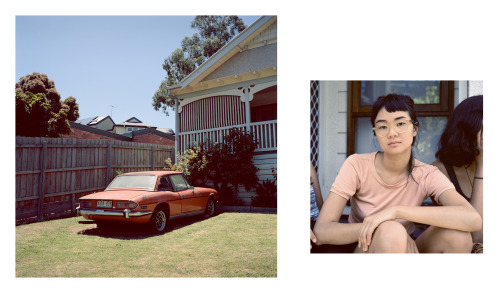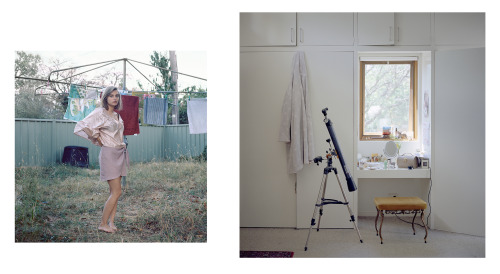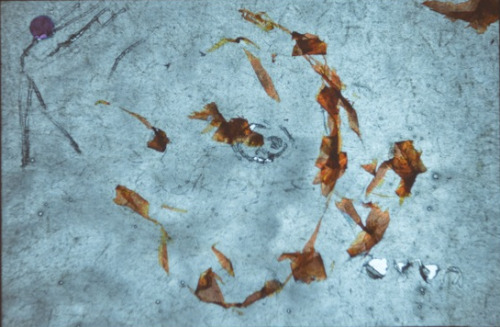
The neighbours weren’t going to fool them this time, 2016

Not a metaphor for hopes and dreams, 2016
Claire Capel Stanley: In the past you’ve been interested in constructing identity through photography, and especially portraiture. In these recent works, you’re including so many other elements - beyond the portrait - in order to construct a narrative, and the text, which is so important to these works, is another element again. I’m wondering if you see these works as exploring more of the notion of identity as constructed and ever-changing?
Madeline Bishop: I see these works as an exploration of storytelling and narrative construction in particular, which perhaps differs from previous works where my focus has been on individual identity construction. After years of almost exclusively taking portraits I had a period where I focussed on how something human could be communicated outside of portraiture, particularly in the series Taken Spaces. Although these were landscape images, my objective was to find human traces among the deserted environments and that exploration has fed into this kind of work where I have returned to using portraiture in conjunction with new elements. I think presenting a combination of image types with text speaks more about the construction of narrative and the slices of information photographers give us to tell a story. It brings the idea of construction to the forefront.
CCS: I really like that idea, because construction is always inherent in photography, even if it’s not always acknowledged as such. I think some of these works have the flavour of something being ‘worked out’, as though you are presenting clues in a novel. They invite questioning. I wonder if there’s a larger question here as well, beyond photography, about how we construct a sense of meaning in our own lives? The line ‘not a metaphor for hopes and dreams’ especially seems to play with traditional notions of success and failure, for instance…
MB: You’re right about that. I took these images whilst working on a project about young women living in share housing. Many of the women I photographed were finishing studying and were unemployed or still working in jobs they considered temporary. In many ways they are located in between what we consider the important or defining stages of one’s life, much like the share house space itself, which is generally considered a transient space. What I find interesting is how we define ourselves when we are in a liminal stage. It seems a common problem with young people that many of us thought we would be in a different place by now and that this ‘in between’ stage has become extended and without a clear ending in sight. Can we continue to consider it a space in between what we should be doing if it becomes almost permanently where we exist?
CCS: It’s a great question, and one that rings true for me too. I constantly feel ‘unfinished’, like I’m still in the chrysalis. I’m kind of intrigued by that state though. In a recent work I made, I used negatives from my own personal archive to make a series of slide projections. I’m not a photographer, but I was interested in the negative as being both a liminal and a leftover- it’s kind of between the initial event and the final image, but also it’s the husk of that image, in a way. You might feel differently as a photographer, but for me it was like retrieving a piece of discarded trash, like the underside or the membrane of the original experience. On another note, I’m interested in how your current works come together. Do you have an idea of the collection of images and text you want to make before you begin, or is it more of an associative process?
MB: That’s an interesting idea about the negative itself, as the use of the negative is almost always the middle of the process, preceded and followed by steps which can alter the image from its previous state. I think it’s interesting that often when we’re talking about ideas of manipulation in photography we focus on the process after the shutter has been pressed. My interest has always been in the process and manipulations leading up that moment, so in response to your question, my process begins a long time before I take a shot. I try to pre-plan as much as I can and I try to make this pre-planning and construction evident in my work. The selectiveness of storytelling is something I have picked up on in your work too. Do you perceive it to be about control or a desire for authenticity in acknowledging the medium’s failings?
CCS: You’re right- storytelling is selective. I don’t think it’s possible to tell a neutral story. There always ends up being some inflexion of voice, or opinion or feeling. I don’t think humans really operate very well when we try to be too factual or objective- it tends to look farcical. Whether it’s photography, or writing, or any other medium, objectivity often comes down to a question of who owns the facts. Whose objectivity are we talking about? I think what we’ve seen that a lot in politics both in Australia, and internationally, where facts- on immigration, or economic policy, for instance- have been used as deeply subjective weapons to serve a range of agendas. I think that’s the reason I am drawn to amplifying the storytelling component, which I find so engaging in your work too. For me storytelling is a way of regaining control and agency, while also admitting the existence of faults and failings, gaps and uncertainty. I suppose it’s a way of drawing attention to the way in which things don’t always add up. That proposition feels quite exciting for me at the moment.

Unswallow, typewritten text on Ilford mounting tissue with beeswax, Claire Capel-Stanley, 2016

Softminded 1, from a series of 14 handmade slides, Claire Capel-Stanley, 2016